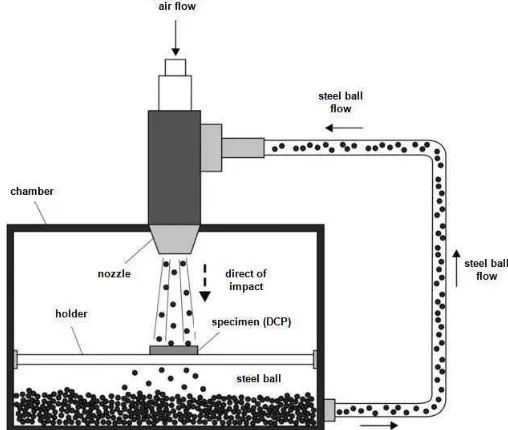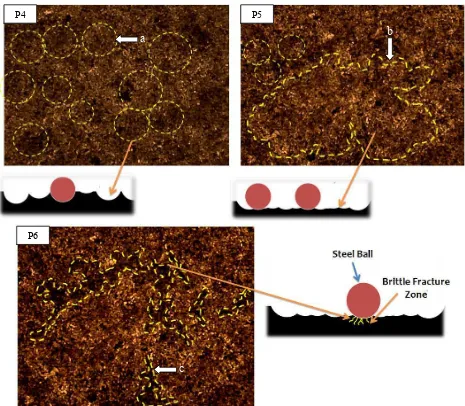Effect of Shot Peening Pressure Variation on Surface Characteristic of
SS-316L Dynamic Compression Plate (DCP)
Yoga Rendra SAPUTRA
1,a*, Panji PRIHANDOKO
1,b, Sunardi
1,
Tutik SRIANI
1,2,cand Gunawan Setia PRIHANDANA
1,2,d1Department of Mechanical Engineering, Universitas Muhammadiyah Yogyakarta, Jl. Lingkar
Selatan Tamantirto, D.I. Yogyakarta, Indonesia
2Centre of Virtual Design and Manufacturing, Jl. Kaliurang km. 10, D.I. Yogyakarta, Indonesia
a[email protected], b[email protected], c[email protected],
Keywords: Dynamic Compression Plate, SS-316L, shot-peening, hardness, microstructure
Abstract. Dynamic Compression Plate (DCP) is a plate made of biomaterials like stainless steel 316L (SS-316L) or titanium, which is used for joining fractured/broken bones for fast recovery. Due to its excellent properties on corrosion, toughness, and hardness; SS-316L is widely used for medical application. Despite its excellent properties, the surface of SS-316L commonly degraded after machining. Therefore, the surface of SS-316L needs to be treated before further use. Shot peening is one of the methods to increase the surface hardness and roughness of material. This research aims to investigate the effect of shot peening to the surface of DCP made of SS-316L from its microstructures, surface roughness, and hardness. In this research, the DCP is designed for joining arms, which are upper-arm (humerus) and forearm (radius and ulna). First we machined the DCP to have holes and bend the plate to match the user bone structure. The DCP is 105 mm × 12 mm × 4 mm in dimension and has 6 holes, 5 mm diameter each, with holes aligned to the plate. After machining, the surface is modified by shot peening using following properties: steel ball (0.4 mm in diameter and hardness 250 HV), 100 mm nozzle-to-plate distance, and shot for 10 minutes. Our parameters are variations in pressure, ranging from 4 to 6 bar. The microstructure of the treated surface was analyzed after shot peening. The result shows that the shot peening treatment of SS-316L has increases its surface hardness and roughness with significant change on its microstructure, which makes a better surface characteristics for DCP.
Introduction
Technological developments in the science of orthopedic surgery are growing larger. New biomaterials are invented to solve the problems that arise in the orthopedic surgery. The used of biocompatible materials is not focusing only for surgical instrument, but also intended for material that compatible as a tool implantation. Tool implantation is a medical aid which is used to replace a missing biological structure, to support a damaged or to enhance an existing biological structure. One of tool implantation which is employed to support the damaged biological structure is called Dynamic Compression Plate (DCP). DCP is connecting implant for upper arm bone (humerus) to forearm (radius and ulna). Common DCP is made of titanium, which is light, tough, strong with high corrosives resistance, and biocompatible material [1]. However, titanium is expensive and considered as one of the most difficult materials to be machined. One of the alternative materials used to replace titanium is stainless steel 316L (SS-316L). Compared to titanium, SS-316L is easily obtained in developing country with reasonable price, and the most important feature of SS-316L is its biocompatibility to be used as an implanted tool [2].
However, the surface of the SS-316L needs to be treated before further used as an implanted tool. In this study, in order to improve the surface property of the SS-316L plate, shot peening treatment is applied at different pressure variation. Shot peening is a method to improve material properties on the surface by firing small abrasive particles at high pressure to create materials plastic deformation. One of the effects of shot peening is the enhancement of mechanical strength of
Applied Mechanics and Materials Submitted: 2016-02-25
ISSN: 1662-7482, Vol. 842, pp 418-422 Accepted: 2016-02-25
doi:10.4028/www.scientific.net/AMM.842.418 Online: 2016-06-21
© 2016 Trans Tech Publications, Switzerland
the treated material [3]. In this research, microstructure, surface roughness and micro hardness of the SS-316L DC Plate before and after shot peening treatment were compared and analyzed to determine the effect of the SS-316L DC Plate mechanical strength after shot peening treatment.
Methodology
Sample Preparation of SS-316L DC Plate
In this study, the researchers use a design that has been investigated previously [1]. SS-316L DCP has 105 mm × 14 mm × 4 mm of length, width and thickness respectively and has 6 holes of 5 mm diameter on its middle line of the plate. The plate design was chosen because the result of the finite element analysis on a plate has the smallest stress distribution value, so that the design fulfills the standard requirements for DCP. Figure 1 shows the surface of SS-316L DCP microstructure before and after grinding process.
Figure 1. Surface of SS-316L by optical microscope; (A: Before grinding process, B: After grinding process).
Shot Peening Treatment
The main principle of shot peening treatment is the use of air compressor and spray gun to fire steel ballss to the surface of material at specified time [4]. The steel ballss were shot peened for 10 minutes with normal direction towards the work surface. Different air pressure variation were performed starting from 4, 5 and 6 bar. The steel balls were circulated and reused for the treatment through a system which is shown in Figure 2. The distance of nozzle to the treated material is fixed at 100 mm. The size of steel balls is 0.4 mm in diameter with hardness 250 HV.
Figure 2. Illustration of shot peening process [5].
Surface of the material before and after shot peening treatment was analyzed. Five different measurement were taken randomly from each sample in order to have a valid result. Optical Microscope with magnification of 500× was used for surface structure analysis. Portable Surface Roughness Tester were used to measure the surface roughness of SS-316L DC Plate. Surface roughness test measured at several different places and the average value (Ra) used for the analysis. Microhardness of the material surface was measured using Vickers.
Result and Discussion
Surface morphology of the treated SS-316L DC Plate
Figure 3 shows the micrographs of the treated specimens under different pressure. P4, P5 and P6 represents air pressure of the fired ball applied at 4 bar, 5 bar and 6 bar, respectively. Compared to the untreated specimen shown in Figure 1, the microstructure in Figure 3 shows some changes in grain size reduction due to shot peening process.
Figure 3. Micrographs of the SS-316L surfaces with illustrations; P4 (air pressure at 4 bar), P5 (air pressure at 5 bar), P6 (air pressure at 6 bar); (A: trace of steel ball, B: fine grain, C: initial crack).
The cracks and traces are indicated by appearance of dark spots on the surface whereas the fine grain appears as the bright one. The smooth surface reflect almost all the incident light from the source towards the microscope. Meanwhile, the irregular surface such craters reflects the incident light in a random direction, so that only a small portion, even none, of the light which can be captured by the microscope.
P4 P5
P6
a b
c
The surface of the treated material is changing by the appearances of the craters and traces caused by steel balls impact on the surface. At P4, visible small grain boundaries can be seen on the surface together with traces of granules on it. At P5, the surface structure is refined due to the proper redistribution coarse granules on the surface. However, when 6 bar of pressure were applied (P6), ball impact created a small crack on the surface. This can be explained that the more pressure used will give deeper traces; result in the appearances of crack on the surface. At higher pressure, there will be a crack in the surface which causing changes of its surface properties.
Surface Roughness of treated SS-316L DC Plate
Figure 4 shows the results of surface roughness measurements for untreated and treated SS-316L DC Plate.
Figure 4. Surface roughness measurement of SS-316L DC Plate.
The graph indicates that surface roughness values increased significantly after shot peening treatment. The roughness average of SS-316L DC Plate without shot peening treatment is Ra 0.5 µm. This result has agreement to the previous research [4], where the surface roughness of the plate after shot peening treatment is increasing up to 90% (Ra 0.95 ± 0.05 µm) from its initial roughness.
Surface Microhardness
Figure 5 presents the surface microhardness value of the SS-316L DC Plate before and after shot peening treatment.
Figure 5. Effect of the applied pressure to microhardness of the SS-316L DC Plate.
Based on the data presented on Figure 5, the hardness of the treated plate is significantly increased. The average of hardness of SS-316L DC Plate without shot peening treatment is 101.32 HV, and the value is increased after the treatment. The hardness increment of the plate after treatment is up to 89% (189.85 HV) of the untreated plate hardness. Furthermore, a microhardness test was performed on the specimens in order to determine the effect of shot peening on the depth of hardening.
Figure 6. The hardness values versus depth of hardening from the surface of specimen.
According to the graph, the hardness decreases as the depth of measurement increases. This indicated that the effect of shot peening to the depth of hardening is proportional to the applied pressure.
Conclusion
Based on the experiment results, we come up to conclusion that the shot peening treatment changes the surface properties of SS-316L DC Plate due to the impact of the steel balls to the plate surface. The changes in microstructure is followed by the increasing of surface roughness of the SS-316L Plate. In term of material hardness, shot peening treatment has increased the microhardness of the SS-316L DC Plate up to 89%.
References
[1] Y. Anggriani, Design, Finite Element Analysis and Fabrication of Prototype Osteosynthesis Plates Implant from Ultra High Molecular Weight Polyethylene (UHMWPE) Material, Gadjah Mada University, Yogyakarta, 2012.
[2] V. Azar et Al, Surface & Coatings Technology 204 (2010) 3546–3551.
[3] T.A. Setiawan, Pengaruh Perlakuan Shot Peening pada Baja AISI 316L Berbentuk Silindris Menggunakan Bahan Abrasive Slag Ball Terhadap Struktur Mikro, Kekerasan, dan Kekasaran Permukaan, Gadjah Mada University, Yogyakarta, 2013.
[4] T. Hidayat, Pengaruh Perlakuan Shot Peening pada Baja Aisi 316L Berbentuk Silindris terhadap Struktur Mikro, Kekerasan, dan Kekasaran Permukaan, Gadjah Mada University, Yogyakarta, 2012.
[5] B. Arifvianto, Surface & Coatings Technology 210 (2012) 176–182.



